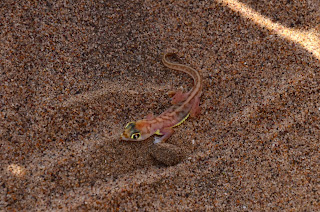We drove through the Namib desert, which Namibia is named for. It is vast with an ever changing landscape. It is most famous for its red dunes, which are spectacular and can be seen for miles. But it also has vast plains, rugged mountains of many colours and lots of life.
We camped in the desert at a guest farm and were caught in a huge downpour (see previous pics), it was the first real rain they had in 3 years. After the rains, flowers bloom and green bursts out everywhere. There are carpets of yellow and green against the red sands, it really is something to see.
Little red "velvet spiders" (they are not really spiders), only come out ofter the rain. Many species are like this, little lizards, spiders, plants, frogs that lay dormant until the rains come. They come to life breed and the cycle starts again.
We took a day tour to Sandwich Harbour which is south of Swakopmund. We drove through the salt works which are huge pans where they pump sea water into the "lakes" and let it evaporate. When its at a certain salinity, they pump it into the next pan. It takes 9 months to get the salt. Most of it is shipped to South Africa for industry use. Its a shame as they have flooded the land and killed all the grasses and desert plants that grow there.
We then drove along the beach to the harbour, there was no one else there. It really is a special feeling to be the only people around. I climbed to the top of the dune and all you could hear was the wind. The view was pretty good, worth the climb, which is tough in sand. If a dune is at a certain angle, when you slide down it, it makes a deep humming noise like a group of airplanes
sunset in the Namib desert after the storm
greater and lesser flamingos
little gecko which does not have eyelids, he is nocturnal. He has to lick his eyes to keep them moist
the dunes come right up to the ocean
gerbil feeding on a desert melon
 |
| white lady of Brandberg, the detail is amazing |
We also saw hundreds of flamingos, that breed in this area. There are the greater and lesser flamingos and the slimier the water, the better for them.
We then headed north to Uis, which is a little town in the middle of nowhere. It used to have a tin mine, which has closed. It has left a huge white "mountain" which you can see everywhere from the town. We then headed to see the "White Lady" of Brandberg. Which is a famous rock painting, thought to be between 2000-5000 years old. It is really a medicine man. The detail and colours are amazing. Its hard to believe they painted it so long ago. Desert elephants also live in this area, we saw their spoor and evidence they had been there, lots of broken trees, but did not see any.
On to Etosha next
Cheers Kim and Dan





No comments:
Post a Comment